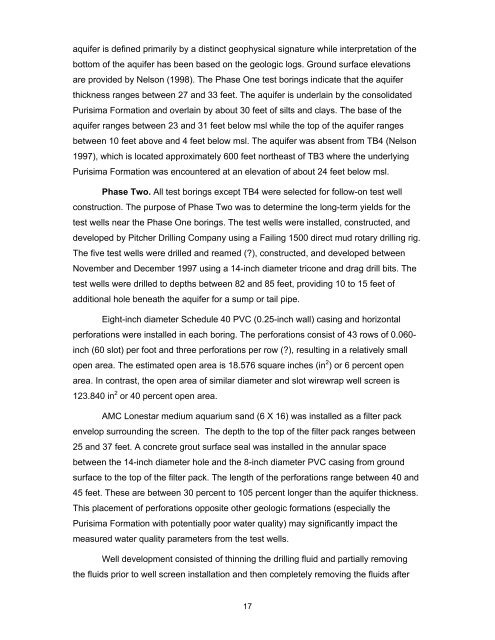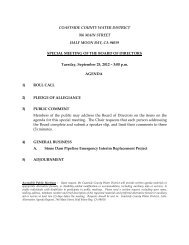Lower Pilarcitos Creek Groundwater Basin Study - Coastside ...
Lower Pilarcitos Creek Groundwater Basin Study - Coastside ...
Lower Pilarcitos Creek Groundwater Basin Study - Coastside ...
Create successful ePaper yourself
Turn your PDF publications into a flip-book with our unique Google optimized e-Paper software.
aquifer is defined primarily by a distinct geophysical signature while interpretation of the<br />
bottom of the aquifer has been based on the geologic logs. Ground surface elevations<br />
are provided by Nelson (1998). The Phase One test borings indicate that the aquifer<br />
thickness ranges between 27 and 33 feet. The aquifer is underlain by the consolidated<br />
Purisima Formation and overlain by about 30 feet of silts and clays. The base of the<br />
aquifer ranges between 23 and 31 feet below msl while the top of the aquifer ranges<br />
between 10 feet above and 4 feet below msl. The aquifer was absent from TB4 (Nelson<br />
1997), which is located approximately 600 feet northeast of TB3 where the underlying<br />
Purisima Formation was encountered at an elevation of about 24 feet below msl.<br />
Phase Two. All test borings except TB4 were selected for follow-on test well<br />
construction. The purpose of Phase Two was to determine the long-term yields for the<br />
test wells near the Phase One borings. The test wells were installed, constructed, and<br />
developed by Pitcher Drilling Company using a Failing 1500 direct mud rotary drilling rig.<br />
The five test wells were drilled and reamed (), constructed, and developed between<br />
November and December 1997 using a 14-inch diameter tricone and drag drill bits. The<br />
test wells were drilled to depths between 82 and 85 feet, providing 10 to 15 feet of<br />
additional hole beneath the aquifer for a sump or tail pipe.<br />
Eight-inch diameter Schedule 40 PVC (0.25-inch wall) casing and horizontal<br />
perforations were installed in each boring. The perforations consist of 43 rows of 0.060-<br />
inch (60 slot) per foot and three perforations per row (), resulting in a relatively small<br />
open area. The estimated open area is 18.576 square inches (in 2 ) or 6 percent open<br />
area. In contrast, the open area of similar diameter and slot wirewrap well screen is<br />
123.840 in 2 or 40 percent open area.<br />
AMC Lonestar medium aquarium sand (6 X 16) was installed as a filter pack<br />
envelop surrounding the screen. The depth to the top of the filter pack ranges between<br />
25 and 37 feet. A concrete grout surface seal was installed in the annular space<br />
between the 14-inch diameter hole and the 8-inch diameter PVC casing from ground<br />
surface to the top of the filter pack. The length of the perforations range between 40 and<br />
45 feet. These are between 30 percent to 105 percent longer than the aquifer thickness.<br />
This placement of perforations opposite other geologic formations (especially the<br />
Purisima Formation with potentially poor water quality) may significantly impact the<br />
measured water quality parameters from the test wells.<br />
Well development consisted of thinning the drilling fluid and partially removing<br />
the fluids prior to well screen installation and then completely removing the fluids after<br />
17



